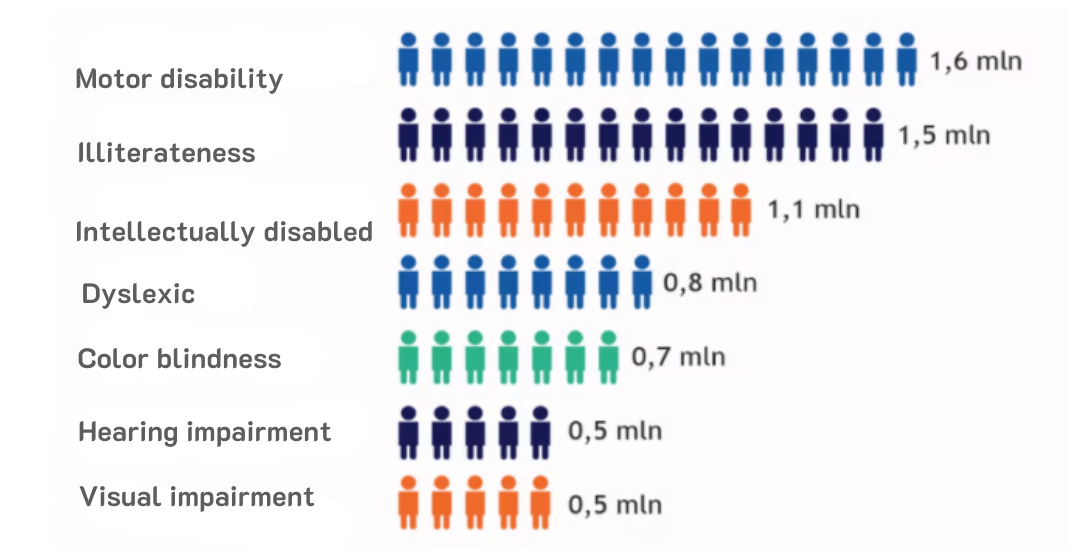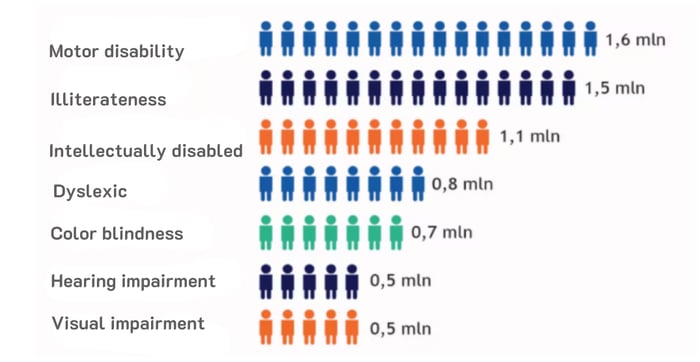Mastering Event Evaluation: Your Comprehensive Guide and Template
Discover the power of event evaluation in driving progress and success. Learn how to master event evaluation with our comprehensive guide and...

In a world where inclusivity takes center stage, it is crucial for events to embody this vision. Organizers must actively strive for diversity on stage, among participants, and in every aspect of their events. The ultimate goal? To represent a wide range of perspectives and backgrounds, ensuring everyone feels welcome and sees themselves reflected. However, let's not lose sight of digital accessibility on event websites and registration forms. aanmelder.nl is eager to share their vision of how they aim to embrace and further develop inclusivity in 2024.
"How can we ensure that everyone in society gets equal opportunities and can fully benefit from digital accessibility?"
Improve the user experience for all visitors with our software. Ensure that everyone can enjoy your event.
Why is it important to have a good website? How can we ensure that everyone in society gets equal opportunities and can fully benefit from digital accessibility? These are essential questions that demand attention and focus on striving for a digital world accessible to everyone, regardless of individual obstacles such as background, gender, age, neurodiversity (including ADHD and dyslexia), visual impairments (such as blindness and color blindness), epilepsy, motor disabilities, and digital skills. This vision aims to ensure equal opportunities and access for all individuals, and this effort is particularly significant within the event sector in 2024.
Accessibility, also known as inclusivity, refers to designing websites and digital content in a way that is usable for everyone, regardless of any limitations. The goal is to provide equal access to information and services.
Investing in accessibility has multiple benefits. It expands your audience, enhances the user experience, complies with legal requirements, and strengthens your brand reputation. An accessible website is a win-win for both you and your visitors.

In striving for inclusion, accessibility for people with diverse challenges is a crucial aspect. Events must commit to being accessible to everyone, regardless of their individual obstacles. The Web Content Accessibility Guidelines (WCAG) document by the World Wide Web Consortium (W3C) offers valuable guidance on digital accessibility. Four of these considerations are:
Tips to make your event website accessible, inclusive, and user-friendly
To make an event website accessible, inclusive, and user-friendly, there are some important considerations.
Accessibility according to WCAG guidelines: One of the most crucial aspects of a good event website is accessibility. The Web Content Accessibility Guidelines (WCAG) are international standards that promote website accessibility. By adhering to these guidelines, you ensure that your website is accessible to everyone, including people with visual, auditory, or motor impairments. This contributes to an inclusive online experience for all your visitors.
Multilingual options and language use: Offering your website in multiple languages enhances usability and inclusivity. Ensure that translations are accurate and understandable, while also considering cultural nuances. Use clear and concise language in all communications, avoiding jargon. This makes your website more accessible to a broader audience.
Mobile-first design: A user-friendly event website must be responsive and function well on mobile devices. As more people use smartphones to access event information, a mobile-friendly design ensures a smooth experience across all devices.
Visual content and videos: Images and videos play a key role in attracting visitors. Make sure that all your visual content is of high quality and loads quickly. Don’t forget to add alternative text (alt-text) to images so individuals with visual impairments can understand the content.
User-friendly navigation: A clear menu structure and intuitive navigation are essential. Visitors should be able to find the information they need effortlessly. Using clear labels and a consistent layout contributes to better usability.
The benefits of accessible design: Investing in accessibility comes with numerous advantages. It expands your audience, improves user experience, complies with legal regulations, and strengthens your brand reputation. An accessible website is a win-win for both you and your visitors.
Why should you invest in accessibility?
Accessibility is not just a moral obligation; it also unlocks new opportunities. Reaching a broader audience and meeting the expectations of the modern internet user are just a few reasons why investing in accessibility is a smart choice.
The future of events: inclusive and accessible
The goal is to transform events into inclusive environments where everyone feels welcome and can fully participate, regardless of their individual characteristics and needs. Understanding and implementing digital accessibility is a crucial step in that direction. In 2024 and beyond, the event industry will hopefully serve as an example of inclusivity and accessibility for the rest of the world. By striving for inclusivity and accessibility, events can not only celebrate diversity but also create a positive impact on society as a whole. Together, we can pave the way for a future where equal opportunities and digital accessibility for everyone are the standard.
Hi busy event manager… Do you have a moment?
Planning an event soon? With Event Management, you can automate and streamline various tasks, allowing you to focus on the event itself. From automating, personalizing, and branding email campaigns to creating an event website, registering participants, selling tickets, managing financial administration, and much more—all from one easy-to-use dashboard.
Try a variety of features now for free for 14 days.
Discover the power of event evaluation in driving progress and success. Learn how to master event evaluation with our comprehensive guide and...
Sustainability and circularity in events: why it matters and practical tips for organizing.
A hybrid event is a combination of an online and offline event in one. Read more about hybrid events and their associated benefits here.